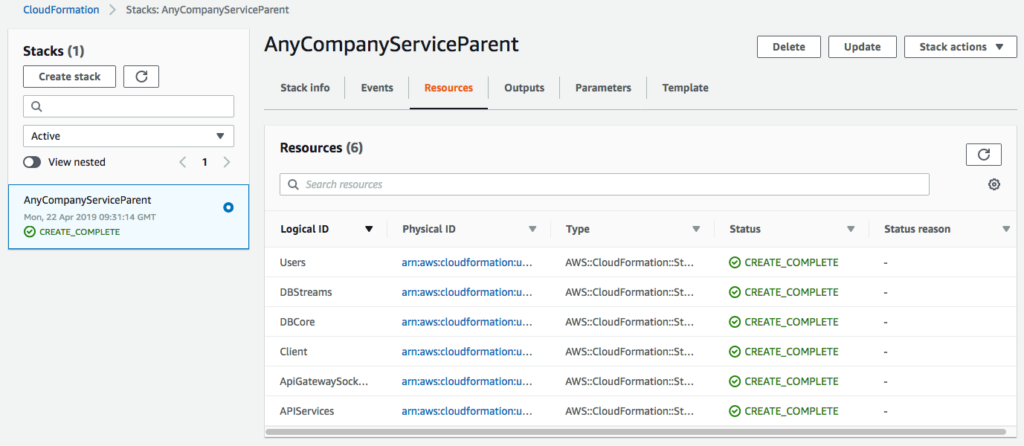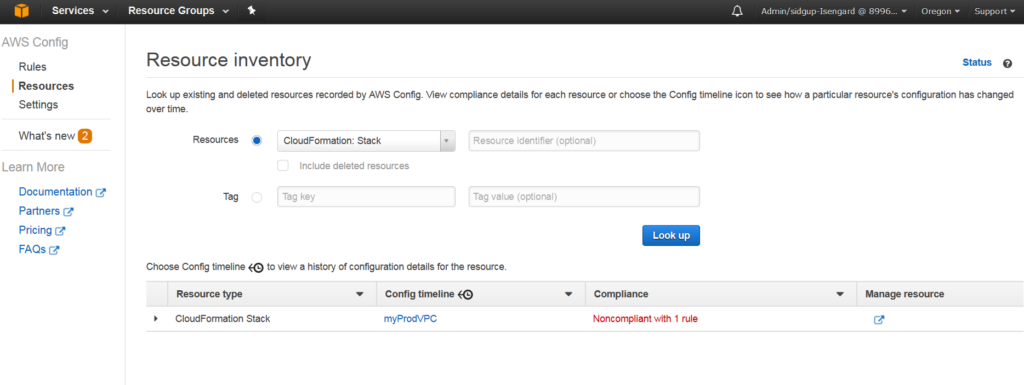As someone with decades of experience in the IaaS software landscape, I understand the challenges and opportunities it offers. You're here to find out if AWS CloudFormation fits your needs, and I aim to give you all the information required to make that decision.

AWS CloudFormation Software Product Overview
AWS CloudFormation orchestrates and manages resources in AWS through automation. Target users include DevOps engineers, cloud architects, and system administrators.
The tool simplifies the process of deploying and managing AWS infrastructure through IaC (infrastructure as code), reducing manual tasks and human error, and also allows the building of serverless applications. In fact, infrastructure involves the administration and provisioning of computer data centers via machine-readable definitions.
Furthermore, its standout features include the ability to use AWS CloudFormation template-based resource provisioning, built-in logic for updates, and robust compliance capabilities.
Additionally, one of the positive things about AWS CloudFormation is that it is compatible with Windows, Linux, and Mac.
Pros
- Template-Based: AWS CloudFormation is open source and uses YAML or JSON templates, making it easier to replicate environments and build a CloudFormation stack.
- Built-in Logic: It allows conditional logic within the templates, providing flexibility in resource deployment. For reusable templates, utilize the sections for parameters, mappings, and conditions to allow stack customization during creation.
- Compliance Features: With AWS Cloud, you get out-of-the-box capabilities for tracking changes and enforcing policies.
Cons
- Learning Curve: AWS CloudFormation's extensive features may overwhelm new users.
- Limited Preview: The service lacks an exhaustive "dry-run" capability, restricting pre-deployment testing.
- AWS-Centric: It primarily focuses on AWS services, which could limit multi-cloud or hybrid cloud implementations.
Expert Opinion
So, after closely examining AWS CloudFormation's features, pricing, functionality, support, and more, I can say it holds its own in a crowded IaaS market. It outperforms competitors in template-based provisioning and compliance, but its learning curve and limited preview functionality can be sticking points.
Furthermore, In terms of user suitability, I'd recommend it for those deeply invested in the AWS ecosystem who prioritize compliance and replicability.
AWS CloudFormation Review: The Bottom Line
What sets AWS CloudFormation apart from other tools is its deeply integrated nature with the AWS ecosystem, making it a robust option for users who are already committed to AWS. Its template-based resource provisioning and compliance features stand out as particularly noteworthy.
Also, CloudFormation allows for the easy version control, and management of AWS and other cloud infrastructures by establishing a complete service stack, simplifying overall system administration and infrastructure management.
AWS CloudFormation Deep Dive
Product Specifications
- Virtual Machine Management - Yes
- Load Balancing - Yes
- Template-Based Resource Provisioning - Yes
- Multi-Cloud Support - No
- Auto-Scaling - Yes
- Block Storage Management - Yes
- Networking Features - Yes
- Database Management - Yes
- Security and Compliance - Yes
- Backup and Recovery - Yes
- Monitoring and Analytics - Yes
- Event-Driven Architecture - Yes
- User Access Control - Yes
- OS Management - No
- API Access - Yes
- Billing and Cost Management - Yes
- Container Management - Yes
- Log Management - Yes
- Infrastructure Orchestration - Yes
- CLI Support - Yes
- Disaster Recovery - Yes
- Firewall Management - Yes
- Data Encryption - Yes
- Self-Service Portal - No
- Resource Tagging - Yes
AWS CloudFormation Feature Overview
- Template-Based Resource Provisioning: AWS CloudFormation uses YAML or JSON templates, making resource replication efficient.
- Load Balancing: Ensures equitable distribution of incoming traffic, optimizing performance and fault tolerance.
- Auto-Scaling: This feature allows for dynamic adjustment of resources based on workload, aiding in cost management.
- Security and Compliance: AWS CloudFormation offers robust security measures, including IAM roles and resource policies.
- Backup and Recovery: Provides native support for AWS backup services, offering peace of mind in data retention.
- Monitoring and Analytics: This tool integrates with AWS CloudWatch for real-time metrics and log management.
- User Access Control: Utilizes AWS IAM for granular control over user permissions and resource access.
- Container Management: Supports Docker and Kubernetes, simplifying container orchestration tasks.
- Event-Driven Architecture: Capable of triggering AWS Lambda functions based on resource state changes.
- Resource Tagging: Allows for custom tagging of resources, which is particularly useful for cost tracking and management.
Standout Functionality
- Template-Based Resource Provisioning: Deeply integrated with the AWS ecosystem, allowing for smooth resource orchestration.
- Event-Driven Architecture: Not commonly found in other IaaS tools; AWS CloudFormation can execute Lambda functions based on resource events.
- Monitoring and Analytics: Seamless integration with AWS CloudWatch allows for comprehensive logging and real-time analytics.
Integrations
- AWS CloudFormation integrates natively with a host of AWS services like EC2, S3, RDS, and Lambda.
- The platform provides an API allowing for custom integration scenarios.
- Add-ons and plugins are available through the AWS Marketplace, further extending its capabilities.
AWS CloudFormation Pricing
- Free tier available with limited features.
- Developer Tier: $50/user/month, offers all basic features and AWS support.
- Enterprise Tier: $150/user/month (min 5 seats), includes premium features and 24/7 support.
Ease of Use
The user interface does require a learning curve, especially for those not familiar with AWS services. Navigation is robust but can be daunting due to the extensive feature set. Moreover, CloudFormation simplifies the complexities associated with handling dependencies between AWS resources.
Customer Support
AWS offers a variety of customer support options, including live chat and documentation. However, the extent of available support often correlates with your pricing tier, potentially limiting access to speedy resolutions for those on lower plans.

AWS CloudFormation Use Case
Who would be a good fit for AWS CloudFormation?
In fact, AWS CloudFormation shines brightest in environments where AWS is already the primary cloud service provider. The tool is most popular among DevOps engineers, cloud architects, and system administrators who are deeply invested in automating AWS resource management.
It works well for industries such as finance, healthcare, and e-commerce, which require robust compliance and security features. Whether you're a small startup or a large enterprise, AWS CloudFormation can adapt, particularly if your team size ranges from a handful of cloud professionals to larger, more specialized units.
Who would be a bad fit for AWS CloudFormation?
If your organization is looking for multi-cloud or hybrid cloud solutions, AWS CloudFormation might not be your best bet. Businesses that require a straightforward, minimalistic UI for casual or infrequent cloud management tasks could also find the tool overwhelming.
It’s generally less suited for environments where quick, one-off resource provisioning is the norm, or industries like early-stage startups that might be sensitive to pricing and prefer a more pared-down feature set.
AWS CloudFormation Review FAQs
What languages do the templates support?
AWS CloudFormation templates support both YAML and JSON.
Can I roll back the changes?
Yes, rollback capabilities are available to undo infrastructure changes.
Does it offer auto-scaling?
Auto-scaling is natively supported and can be configured within the templates.
Is there a free tier available?
AWS CloudFormation does offer a free tier with limited features.
How does it handle security and compliance?
AWS IAM and custom policies can be used for stringent security and compliance requirements.
Can it manage non-AWS resources?
AWS CloudFormation is primarily focused on AWS resources and is limited in managing non-AWS resources.
Does it support containers?
Yes, it has native support for Docker and Kubernetes.
Are there any third-party integrations?
While there are limited third-party integrations, it does support native AWS integrations extensively.
Alternatives to AWS CloudFormation
- Terraform: Ideal for those looking for a tool that supports multiple cloud providers, not just AWS.
- Azure Resource Manager: A robust option for those already invested in the Microsoft Azure ecosystem.
- Google Cloud Deployment Manager: Offers a simpler user experience and is a good choice for Google Cloud-centric businesses.
Check out other alternatives in this article on the best IaC tools.
AWS CloudFormation Company Overview & History
Amazon Web Services (AWS) is the company behind AWS CloudFormation. As a leading cloud service provider, AWS is used by a myriad of businesses ranging from startups to Fortune 500 companies. The company, a subsidiary of Amazon, operates its headquarters in Seattle, Washington.
AWS has a notable team led by a seasoned group of cloud professionals. Its mission is to empower businesses to manage and scale their resources efficiently. The service has seen numerous updates since its inception, each aimed at enhancing its resource management capabilities.
Summary
In conclusion, AWS CloudFormation offers a robust set of features that work seamlessly within the AWS ecosystem. Its template-driven resource management and strong compliance features make it an ideal fit for larger teams and industries with complex infrastructure needs.
However, the tool might be overkill for businesses seeking a simple solution or those operating in a multi-cloud environment. So, feel free to share your experience with AWS CloudFormation; your insights could help others make more informed decisions.
